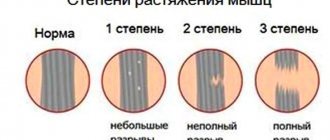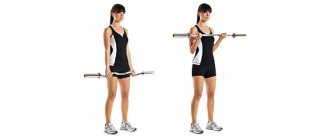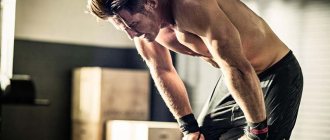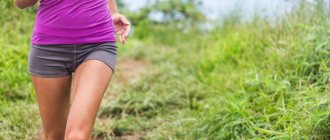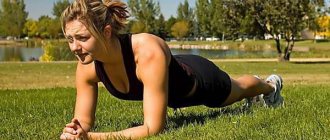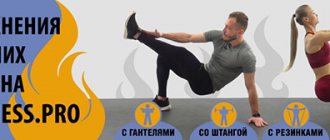What is a muscle strain?
Muscle strain is muscle damage that occurs as a result of rupture of muscle fibers as a result of overexertion. There is also the potential for local bleeding and bruising if the damage from the rupture is extensive enough to rupture small blood vessels.
Muscle strains can occur both during physical activity and during everyday, routine tasks, such as cooking or shopping.
And now for some embarrassing stories...
A week after my 30th birthday, I sneezed and... strained my back. It was so painful that I simply could not walk; I had to move around the apartment on an office chair on wheels.
No matter how stupid and embarrassing this situation may seem, it makes some sense. The muscle strain was due to a sudden, uncontrolled movement that my body was simply not prepared for.
Such sudden movements, unusual for the body, often cause muscle strain, since the body is not ready for such actions. It’s not for nothing that we do a warm-up before training. Another common cause of sprains is overexertion. For example, if you, in pursuit of more defined legs, start doing bench presses with excessively heavy weights, you risk getting a strained calf muscle, a thigh strain, and even foot damage.
Causes and provoking factors
There are only two reasons here. Paradoxically, they are diametrically opposed. The first is high physical activity. Professional sports activities place enormous stress on the entire musculoskeletal system. Most often, ankle injuries occur in those who play team sports - football players, basketball players. In addition to the general heavy load on the lower extremities, basketball players have a provoking factor such as jumping.
Upon landing, there is a short-term increase in body mass and kinetic energy. If a basketball player falls at the same time, then you can imagine that an ankle sprain is one of the joint injuries that can happen. For football players, a sprain or even a fracture of the ankle can occur when hit. When one player tries to kick the ball and instead hits another player's shin with the studs of his boot, the injury can be very serious.
The second reason is low physical activity. In this case, lack of movement provokes weakness and low elasticity of the ligaments. The atrophied ligamentous apparatus is not able to cope even with everyday stress. In particular, such people can get a sprained ankle just by twisting their ankle.
Among the factors provoking this condition are:
- Flat feet. Incorrect anatomy of the foot is a serious disadvantage of this joint. Flat feet have an extremely negative effect on the functioning of the entire musculoskeletal system, especially the spine and lower extremities.
- High heels. Walking on such shoes is fraught with frequent falls. Even if you twist your ankle, you can unexpectedly encounter a lower leg injury. This also includes uncomfortable shoes.
- Elderly age. People over 55 years of age experience dystrophic changes in the skeleton. This leads to arthrosis and gait disturbances, which further increases the likelihood of damage to the lower extremities.
What to do in case of sprained ligaments and muscles in the first 24 hours
I will divide the following tips into 3 parts so that you understand what actions to take at each stage and recover as quickly as possible.
Please note that the following methods are only suitable for the first 24 hours after injury!
Rest
The first necessary and mandatory step is to completely stop doing what led to muscle strain. I can't count the number of times I've seen people injure their backs while working out, but continue with the exercise and decide to "get over" it. This approach always worsens the condition.
If you get injured at the gym, the rule of thumb is to stop working out immediately and go home to begin treatment as quickly as possible.
It is very important to stop stressing the muscle to avoid further damage. Over the next 24 hours, try to avoid movements that use the injured muscle as much as possible. And now we are talking not only about sports.
Ice
The sooner you apply ice to the injured area, the better. Hold the cold compress for 20 minutes, then let the muscles rest a little for 20 minutes, then apply ice again, and so on 2 more times.
Ice will help reduce pain and reduce the likelihood of a bright bruise. This is the main property of ice. By itself, it does not contribute to recovery in any way, being only a good pain reliever.
Important! Do not apply ice directly to the skin. Wrap it in a towel.
Tight bandage
A tight bandage will help support the injured muscle. However, make sure that the bandage is not too tight and does not cut off blood flow.
Lift up
If possible, for example, if you have pulled a muscle in your arms or legs, keep the injured part of your body above the level of your heart. This will help avoid significant bruising. If this is not possible, don't worry.
Classification of knee ligament rupture
- 1st degree – sprains and micro-tears of the ligament fibers. The patient feels pain in the knee, it may become swollen and red. The functionality of the joint is slightly reduced.
- Grade 2 – a large number of torn fibers. The function of the joint is partially preserved. Symptoms are more pronounced.
- Grade 3 – complete rupture of the ligament. Severe pain, hematoma, possible hemarthrosis (accumulation of blood in the joint), swelling, instability of the joint, inability to stand with support on the injured leg.
If there is any suspicion of injury, a tight bandage should be applied from the lower third of the thigh to the middle of the lower leg and the patient should be taken to a specialized hospital.
Next 2-3 weeks
Stop using ice 24 hours after injury. Several recent studies have confirmed that prolonged use of ice for sprains slows down the recovery process.
The irony is that Dr. Gabe Mirkin, who created the popular “rest + ice” regimen, now refutes it himself:
“Many athletes have used my approach for decades to solve the problem of sprains, but it turned out that using ice in conjunction with rest, on the contrary, slows down the healing process of the wound. In a recent study, athletes were told to train so intensely that they developed severe muscle damage, causing severe soreness. Although cooling delayed the onset of bruising, it did not speed up recovery."
As it turns out, ice actually delays the healing process because it prevents blood flow to the damaged area, preventing the cells responsible for repairing damaged tissue from reaching their target. In addition, even after the ice is removed from the skin, the cooling effect, which impedes blood flow, continues for at least another 2-3 hours.
But it’s not just ice that should be avoided during this period of time.
As you may have noticed, Dr. Mirkin mentions that a combination of cooling and rest slows down the recovery process. Many of my clients confirm this theory.
Your goal for the next 2-3 weeks should be muscle recovery. Gradually increase the load, returning to the usual. But stop as soon as you feel pain.
Pain doesn't just happen. Also, during the recovery period, try to drink enough water, at least 10 glasses a day. Additionally, you can take fish oil.
Water and fish oil maintain and improve the elasticity of muscle tissue, and also reduce pain and inflammation. These two “supplements” should be present in your diet in any case, but in case of injury you should pay special attention to this.
As for training, I can advise you not to stop training. However, during the recovery period, try to significantly reduce the load and avoid doing exercises on the damaged part of the body. For example, if you have a shoulder strain, you can still train your legs without any problems.
On the other hand, if you have injured your lower back and are experiencing some problems with balance, then it is better to give up going to the gym for a while.
Prevention
With frequent ankle injuries, it is much easier to take preventive measures to avoid damage. These primarily include giving up heels and replacing everyday uncomfortable shoes with anatomically correct ones.
Elastic bandages on the ankle will help reduce the likelihood of injuries in the joint. These bandages also help to warm up the muscle tissue underneath more quickly.
If a person is involved in sports professionally, then during training they need to wear special elastic bandages on this area, which minimize the possibility of damage to the ankle during a fall or impact. And of course, before exercise you need a mandatory warm-up, which will help warm up your joints well before loading.
High-quality restoration of damaged ankle ligaments is only possible with the help of a professional. Recommendations from a specialist will help to effectively and correctly restore mobility to the leg and an active life to the person.
When Canadian figure skater Annabelle Langlois broke her fibula in a training accident just over a year before the 2010 Olympics, doctors tried every possible means to rehabilitate her as quickly as possible, including two surgical operations. However, what they absolutely did not recommend to the athlete was long-term rest for the injured leg.
Over the past few decades, doctors have changed their minds about what is the best treatment for sports injuries, whether it's a sprained ankle, pulled muscles or even broken bones.
After 2-3 weeks
After 2-3 weeks the pain should go away and you should be back to your normal self. Again, this is a minor injury. If the damage is more serious, consult a doctor.
The waiting time, 2 or 3 weeks, is completely determined by you. You know your body better than anyone else.
You can now return to exercises that target the injured muscle. But don't overdo it, start with a lighter weight. The very last thing you should be looking for at this stage is re-injury. I prefer to reduce the load by 50% at first. If all goes well, I increase it to 70% and stay at that weight for the next couple of weeks. Even if you feel strong, never return to your previous load right away.
You can also add a few exercises to stretch the injured muscle. In this case, also start with lighter versions of the exercises. Stretching will help restore mobility that may have decreased during the forced rest.
And finally, I advise many people to do a deep massage during this period. This will help avoid the formation of scars, which cause chronic pain and often make it impossible to fully recover.
Classification of injuries
An ankle sprain is accompanied by pain symptoms that appear depending on the degree of damage. Signs of pathology are nonspecific and can be observed with bruises, dislocations or fractures, therefore, informative diagnostic methods are needed to draw up a clinical picture.
There are 3 degrees of sprains:
A sprain is not life-threatening, but requires treatment and a course of physical therapy, otherwise in the future the problem will become chronic, and the risk of repeated injuries will increase. Complications are fraught with abrasion of the articular cartilage and the appearance of arthrosis.
A few words about painkillers
You probably noticed that the entire article never talked about pain medications, and that's for a reason. I'm actually not a fan of using painkillers for minor muscle strains.
As mentioned earlier, the pain did not just appear. Pain is a protective mechanism that helps you avoid making an injury worse by overexerting the injured muscles. Once you get rid of pain, you will not be able to understand where to stop and can harm your body even more.
Methods for diagnosing pathologies associated with seizures
As already mentioned, muscle tightening is associated with a number of pathologies. The final diagnosis depends on the frequency of occurrence of the symptom, its “strength”, as well as the location.
To accurately identify the problem, it is necessary to first assess the patient’s condition.
His story about heredity, habitual lifestyle, nutrition, and physical activity will help to more accurately assess the picture of the disease.
As additional methods, doctors use:
- Clinical blood tests;
- Ultrasound;
- MRI;
- CT;
- Doppler ultrasound (for vascular diagnostics) and others.
